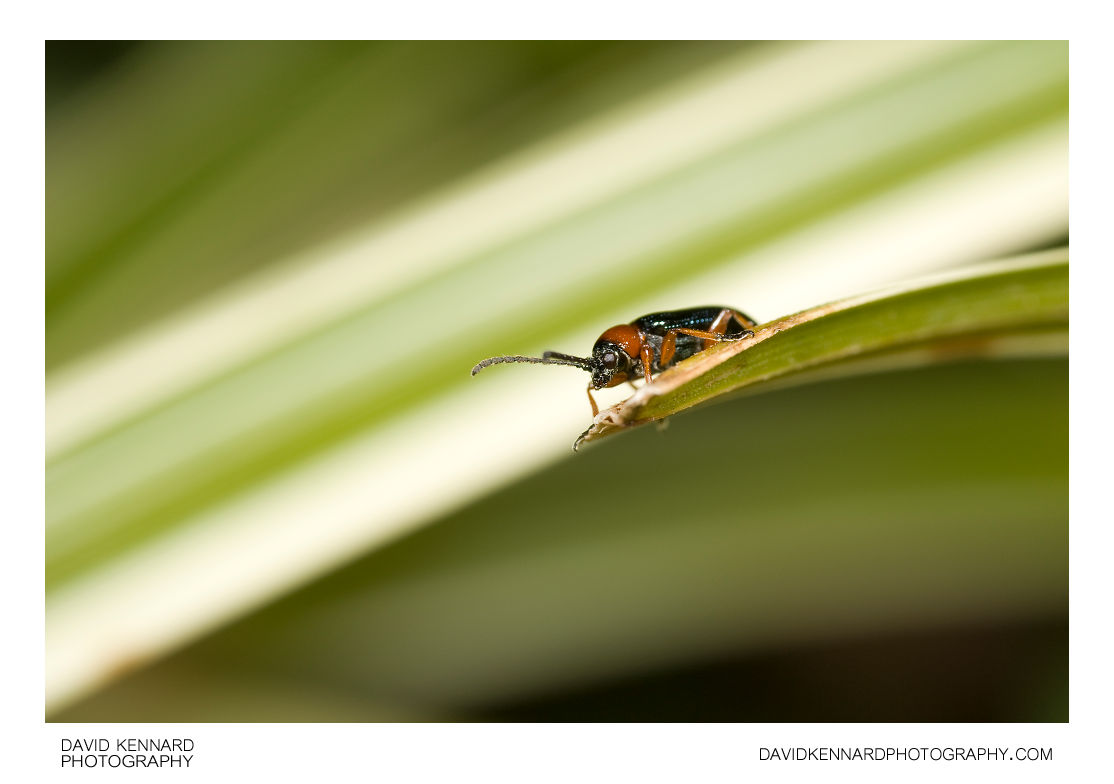Oulema melanopus / rufocyanea Cereal Leaf Beetle

Description
- Title:
- Oulema melanopus / rufocyanea Cereal Leaf Beetle
- Caption / Description:
-
An Oulema sp. Cereal Leaf Beetle. The beetle may be Oulema melanopus or Oulema rufocyanea, but it is impossible to distinguish between these two species without genitalia examination.
In this photo the beetle is climbing along a blade of variegated decorative grass.
From Wikipedia (http://en.wikipedia.org/wiki/Cereal_leaf_beetle):
The cereal leaf beetle (Oulema melanopus or Lema melanopa) is a coleopter, belonging to the family of Chrysomelidae, and an agricultural pest and biological control success story. The beetle is mostly blue-black in color, with an area of deep red just behind the head. The legs are dull orange.
The most common host plants of the cereal leaf beetle are barley, oats, and wheat, but they are also found on rye, millet, rice, many types of wild grasses, and new corn shoots. The beetle has a history as a major crop pest in Europe, Asia, and parts of north Africa, but serious eradication efforts did not begin until the pest began to destroy oat fields in the United States in the 1960s. Insecticides were used without success, but when natural enemies of the beetle were discovered, imported, and released in affected fields, the cereal leaf beetle came under control.
The cereal leaf beetle overwinters in fields of wild grasses, and as the weather warms in the spring, it enters cultivated fields and deposits eggs. The larvae emerge and cover themselves with their own excreta to mimic the droppings of birds or other insects. They usually appear as shiny, wet lumps adhered to the surface of leaves. They gorge on the plants, then drop off and pupate in the soil for about three weeks, emerging full-grown to continue feeding on the plants.
Both adults and larvae prefer young plant shoots or areas of new growth on established plants. Damage from cereal leaf beetles is apparent when the tips of leaves turn white and the leaves develop white stripes or slits where the beetle has consumed a strip. A field with extensive damage will look frosted or whitewashed.
- Tags / Keywords:
-
- Biota
- Life
- Vitae
- Eukaryota
- Animalia
- Animals
- Arthropoda
- Arthropods
- Insecta
- Insects
- Coleoptera
- Beetles
- Chrysomelidae
- Leaf beetles
- Oulema
- Oulema melanopus
- Oulema rufocyanea
- Cereal Leaf beetle
Admin
- Date Original Photo Taken:
- Original File Name:
- _MG_6424.CR2
- Event:
- Rating:
- ☆
- Date this image added/last updated on website:
- Original File Dimensions:
- 4272px x 2848px
- File Type:
- JPEG
- Color Mode:
- Original Image Color Profile:
- Adobe RGB (1998)
Location
- Location Created:
-
- Sublocation:
- City:
- Market Harborough
- Province/State:
- Leicestershire
- Country:
- United Kingdom
- World Region:
- Europe
- Geo-location:
Rights
- Copyright Status:
- Copyrighted
- Licensing Status:
- Rights Managed
- Available for Editorial Use:
- Yes
- Available for Commercial Use:
- Yes
- Copyright Notice:
- © 2008 Dave Kennard
Camera Data
- Date Digital Resource was created:
- Shutter speed:
- 1⁄200 s
- Aperture:
- f/8
- Camera Model:
- Canon EOS 450D
- ISO:
- 100
- Exposure Compensation:
- 0
- Focal Length:
- 65mm
- Focal Length (35mm equiv.):
- Metering Mode:
- Multi-segment
- Flash:
- On, Fired
- Exposure Mode:
- Manual
- White Balance:
- Manual
- Light Source:
- Exposure Program:
- Manual
Additional shooting metadata
- Lens:
- Canon MP-E 65mm F2.8 1-5x Macro
- Filters used:
- Additional Optics used:
- Setup:
- Handheld
Canon MT-24EX Macro Twin Flash
Post Processing
- Image Modified:
- Software used:
-
- Adobe Camera RAW
- Post Processing:
